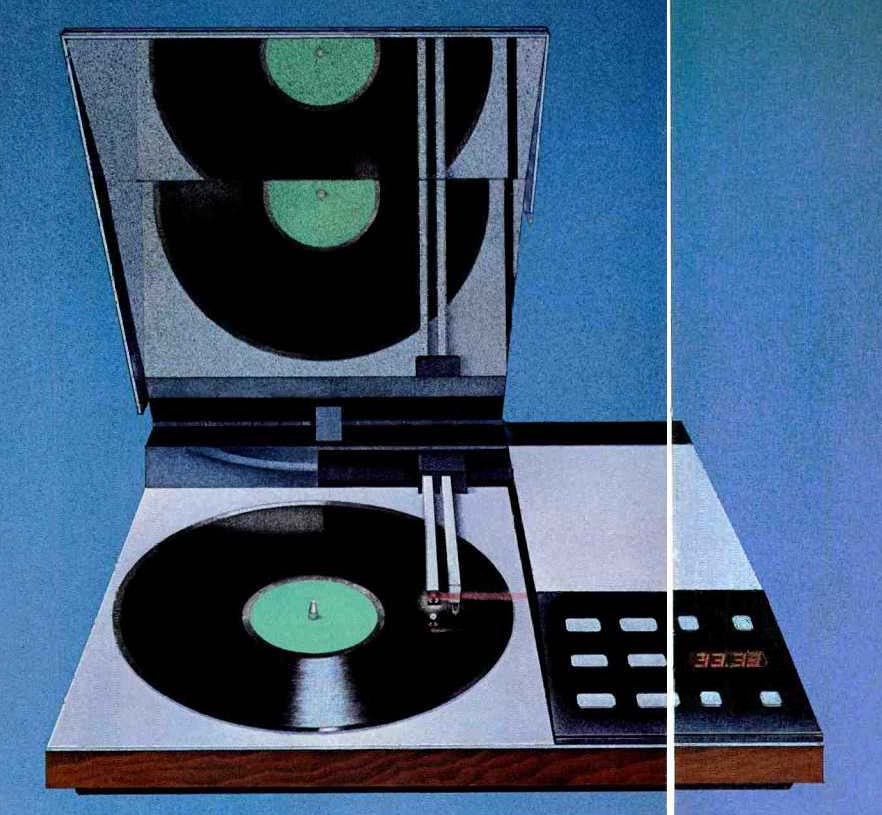
by Gary Stock
By many indications, 1981 will be the year of the straight-line tracking (SLT) turntable--not only among serious audio enthusiasts but also among those who favor compact hi fi systems. After a long period of dormancy, the radial track is back and avail able in exotic separate versions as well as moderately priced high-style forms.
The reasons behind this SLT renaissance aren't that hard to discern. As is common in audio development, it is a combination of technical and market-related factors that have revived the concept rapidly and with broad support. On the one hand, cartridge and disc quality have both improved enormously in the past five years, "upping the ante" for turntable and tonearm makers in terms of the audibility of tracking and platter-system aberrations. A well-designed straight-line tracking turntable can now--for reasons we will discuss in greater detail a bit further on--be expected to sound better on many recordings than its conventionally pivoted counterpart, where a few years ago the subtle distinctions between the two arm types would probably have been lost in the haze of cartridge- and disc-induced colorations.
Technology spun out of other fields has also made improvements in SLT performance and simplicity of construction possible. Most contact-style video disc formats. including JVC's VHD system and RCA's SelectaVision, use fairly elaborate servo systems to drive their radial arms since the stylus pressures of videodiscs are too small to permit free (wholly groove-controlled) tracking. This technology has already been worked into some of the currently available SLT turntables, most notably into Mitsubishi's vertical units and JVC's LE-5, and other SLTs are likely to benefit from it as well.
The biggest impetus to the SLT's re turn, however, probably has to do with its attractiveness as a distinctive concept in the marketplace. The major Far Eastern and European suppliers of turntables understand well that newness is the sizzle which sells the audio industry's steak. The introduction of metal-particle tape acted to generate very high sales volume in replacement cassette decks; it was a well-promoted, distinctive concept that promised real and audible benefits to those who bought it--and it also occurred at a time when technology in the cassette deck field had been stagnant (or at least slowly evolutionary) in most areas for several years. The turn table business is at that same point in 1981--waiting for the next big, distinctively marketable idea to come along now that the direct-drive concept has been widely accepted. And the straight line tracking turntable offers not only sleek cosmetics, an easily explained scientific raison d'etre (it plays the record the same way it was made--what could be simpler than a straight line?), and a well-researched foundation in currently available technology but also the promise of better-sounding music.

Technics SL-15
It's not surprising, then, that many of the major manufacturers have made incursions into the field. Technics has had their record-jacket-sized SL-10, with a short SLT arm and integral moving-coil cartridge mounted in the dust cover, on the market for more than a year. It is being joined this year by a smaller, less expensive version, the SL-7, and a more complex programmable unit, the SL-15.
Two other larger SLTs will later appear in the Technics line-up, both with features oriented toward the serious audio enthusiast. Pioneer has been selling their massive Linear 1 SLT in Japan for some time but has chosen for the moment to market its innovative arm mechanism in this country as part of the Model 8000 turntable from their subsidiary, Phase Linear. JVC has not only a micro-component system with miniature SLT turn- table, but a new separate turntable, the LE-5, based on the component system's unit. Yamaha has the PX-2, complete with massive undercarriage and an elaborate superstructure. Mitsubishi Audio has charged into the field with two separate turntables--including the LT-5V that plays the disc vertically and a conventional horizontal player, as well as a complete integrated music system with vertical SLT turntable. Sharp has an SLT music system, the V2-3000, which plays both sides of a disc without turning it.
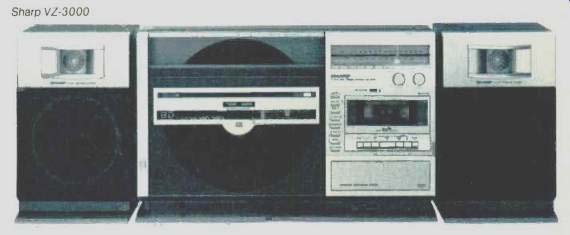
Also in on the radial-tracking ground floor are Aiwa, which has had their programmable LP-3000U out for more than a year; Benjamin Electroproducts with their pull-out 4100 automatic; Revox, which makes two units, both with an unusual and sophisticated light-controlled arm assembly called the Linatrak, and Bang & Olufsen, whose early Beogram 4000, available since 1973, has now been supplanted by two units (the Beogram 4004 and Beogram 8000) de signed to work with B & O's own cartridge series. The builders of the ground floor--Harman-Kardon, whose now-absorbed subsidiary Rabco originally popularized the concept in the mid-'60s--have remained in the field with two units that employ a mechanical servo arrangement, the ST-7 and ST-8. At the esoteric end of the SLT line-up are two newcomers: Dennesen, with its gold plated, air-column supported ABLT-1 , and the French firm Goldmund, which markets a separate SLT arm with out board control box. On the horizon are introductions from several of the other large Japanese suppliers, some at prices expected to be in the middle ranges.
SLTs can be divided into two basic camps relative to their theory of operation. The first and predominant category encompasses servo-controlled units, those in which some control mechanism observes the tonearm's motion as it deviates from tangency and then acts to correct that deviation by moving the tonearm inward. Servo mechanisms need not be electronic in nature, though most SLT servo systems are; there are mechanical, hydraulic, and thermal servo devices in use in a wide variety of industrial products. The original Rabco arm used an extremely straightforward servo system: When the arm deviated, it fetched a gold wire hanging vertically up against a platinum spring, thus completing an electrical circuit which supplied current through a one-transistor amplifier to the tracking motor. Contemporary ser ve mechanisms are more complex. As shown in the accompanying figure, the Linatrak from Revox uses a complex LED-photodiode assembly that in turn activates the motor through a controlling integrated circuit. Other systems are equally involved and often microprocessor activated.
A second, rare category of SLT has what might be called a "freewheeling" tonearm, in which the entire arm assembly is drawn inward by the groove pulling on the stylus. The problem with the freewheeling approach is friction; it must be extremely low (on the order of a few milligrams) to prevent a high-compliance stylus assembly from bending sideways instead of pulling the arm along with it as the groove spirals inward as it ought. Only Dennesen, whose air-bearing arrangement is essentially frictionless, uses this approach currently.
Why should a straight-line tracking arm sound better than a conventional one? Skeptics note that the actual angular deviation in many SLTs is almost as large as in a conventional arm; a 10-inch pivoted arm has a maximum tracking error of 1.72 degrees, according to standard theory. Straight-line tracking arms are set up to correct their position only when deviation from tangency exceeds a degree or so--meaning that they are almost constantly in a condition of substantial angular error. The pivoted arm proponents also note that the quality of performance with a properly designed pivoted arm does not suddenly and radically improve at the two points where such an arm is precisely tangent to the record groove.
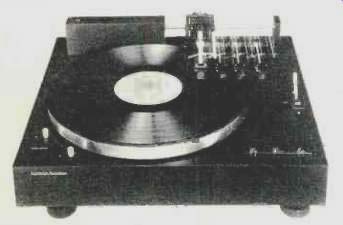
Harman-Kardon ST-8
Supporters of the SLT concept reply by noting that the virtues of this concept may have little to do with the notion of angular accuracy. Rather, it may be the often unmentioned absence of skating and anti-skating forces that gives the best radial-tracking turntables their transparent sound. In a pivoted arm, skating forces that vary widely from one moment to the next (dependent, according to classic studies, upon groove radius, modulation of the groove, and a variety of other factors) vary the degree of lateral pressure upon the stylus assembly, while a single, unchanging (and therefore approximate) anti-skating force provides long-term compensation but not moment-to-moment correction. Hence the stylus is almost continuously in the midst of a lateral tug of war between opposed forces. A straight-line tracking arm eliminates that pair of opposed forces and allows the stylus to do only what it is intended to do--track the groove. Such a theory is difficult to prove directly, but it's interesting to note that the one type of conventional tonearm also theoretically free of this tug-of-war effect, the electronically servo-controlled arm format of Sony and JVC, also seems to exhibit an improved transparency in the view of many listeners.
The next big step in record-playing technology after the SLT will probably be their march into oblivion, since digital audio discs and consumer PCM recorders are coming on more rapidly than many observers had expected. For the hundreds of millions of phonograph records in existence, though, the radial-tracking approach may well represent the Best That Will Ever Be in terms of disc play back quality.
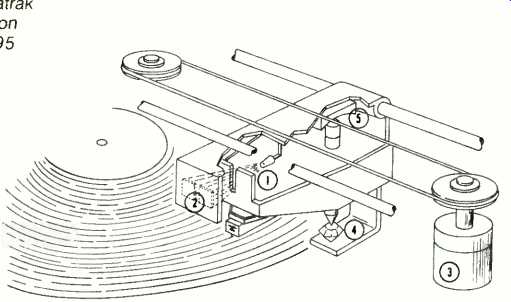
above: Exploded view of Linatrak mechanism featured on Revox 8790
and 8795 turntables. Legend: 1 is LED, 2 is photo diode, 3 is arm drive
motor, 4 is jewel pivot, and 5 is magnetic support.
=============
THREE APPROACHES TO ARM ACTUATION
In A, the arm is propelled inward or outward by rotation of a threaded rod or worm gear arrangement, sometimes the motor attached directly to the threaded shaft itself. Also common, approach B uses a stretched cord or wire attached by an arrangement of pulleys to a motor; this may improve arm/motor isolation somewhat, depending on the specifics of the design. Approach C employs a constantly rotating shaft of larger diameter contacted by a wheel whenever the arm deviates from tangency. It is proprietary to Harman-Kardon turntables. Approach D, used by Pioneer, employs a long electromagnet to induce motion by magnetic force. A fifth approach, used only by Dennesen at present, is to permit the arm to freely respond to groove motion without any servo mechanisms. A low-friction bearing permits independent arm motion.
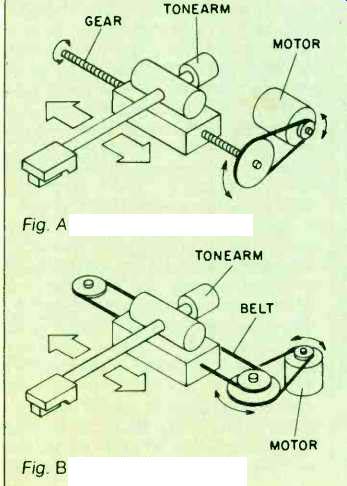
Fig. A--Gear drive method. Fig. B--Belt drive method.

Fig. C--The runner method.

Fig. D--Structure of the linear motor.
============
============
A SHORT HISTORY OF THE SLT
The concept of a radial-tracking tonearm is one of such simplicity that it's been attracting inventors and amateur constructors since the dawn of hi-fi.
One man closely associated with the popularization of the SLT arm was Jacob Rabinow, the celebrated servo-systems engineer who founded Rabco (later absorbed by Harman-Kardon) and de signed the original SL-8E separate SLT tonearm and the ST-4 integrated SLT turntable. His patents in the tonearm field date back to the early '60s and cover not only radial tracking systems but also counterweight decoupling and an extraordinary tonearm system that supports a cartridge on a sort of trapeze made of cords. Rabinow's basic theory--an SLT that uses mechanical means to servo-correct--survives to this date in the Harman-Kardon ST-7 and ST-8.
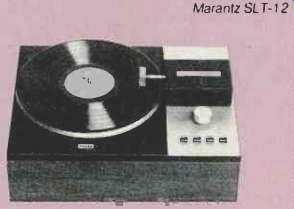
Marantz SL T-12
Rabinow was not the first SLT developer, however. Aside from unverified reports of prewar SLTs, there is a 1958 patent issued to Orthosonic that de scribes a mechanically actuated SLT; seasoned audiophiles may remember the Bard SLT arm. Audio presented a construction project in May 1966 called "The Servo Groove Tracker," and Great Britain's Wireless World also carried a long and detailed letter describing a home-brew SLT arm in January of that year. Our own 1969 review of the first SL-8E comments 20 years in advance on current SLT servo systems, with the author of the review noting that "Mr. Johnson [in his earlier construction article] suggested a lamp which illuminated either of two photocells depending on the position of a mask. The idea would have worked perfectly, although the de vice would have been unduly complicated." Marantz took a stab at SLT development in the mid-'60s with their SLT 12, which employed a gear mechanism to move an arm that extended out over the record like a fishing pole. SLT technology reached the apogee of complexity with Elwood Norris' fabled, ill-fated SSI tonearm. Patent literature shows a number of Norris patents on a complete changer mechanism for the SSI, but the concept and the company never quite got rolling.
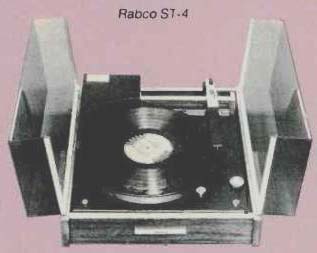
Rabco ST-4
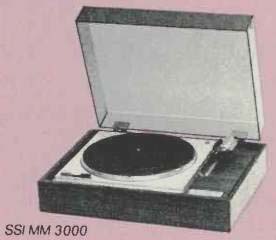
SSI MM 3000
The microprocessor--integrated circuit, which permits engineers to construct "smart" yet inexpensive servo systems, capable of remembering multiple commands and executing multiple simultaneous actions, will probably put an end to the tradition of SLT basement tinkers, but we'll always have an intriguingly diverse history of development to look back upon.
-G.S.
==============
(Adapted fromAudio magazine, June 1981)
Also see:
Which Tracks Best--A pivoted or a radial Tonearm? (Jun. 1982)